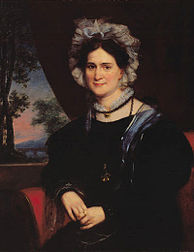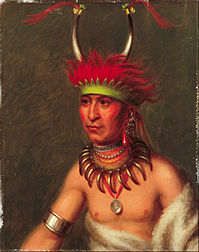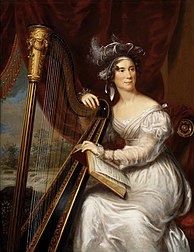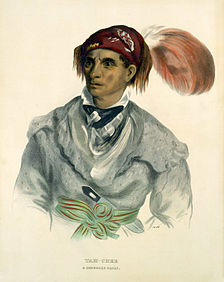User:Catarinaper/sandbox
Charles Bird King (September 26, 1785 – March 18, 1862) was an American portrait artist, best known for his portrayals of significant Native American leaders and tribesmen. His stylistic approaches derived mostly from Dutch influences is seen most prominently in his still-life and portrait paintings. Although King's artwork was appreciated by many, it has also been criticized for its inaccurate depictions of Native American culture.
Charles Bird King | |
|---|---|
 Self-portrait, aged 70 | |
| Born | September 26, 1785 |
| Died | March 18, 1862 (aged 76) |
| Nationality | American |
| Education | Edward Savage in New York, and Benjamin West at the Royal Academy in London |
| Known for | Painting, including portraiture, still life, and genre |
| Notable work | Native American portraiture commissioned by the United States Government from 1822 to 1842 |
| Patron(s) | John Quincy Adams, John Calhoun, Henry Clay, James Monroe, Daniel Webster and William Henry Tayloe |
Biography
[edit]
Charles Bird King was born in Newport, Rhode Island, the only child of Deborah (nee Bird) and Zebulon King, an American Revolutionary veteran and captain. The family traveled west after the war, but when King was four years old, his father was killed and scalped by Native Americans near Marietta, Ohio. Because of this, Deborah King took her young son and moved back to her parents' home in Newport.[1]
When King was fifteen, he went to New York to study under the portrait painter Edward Savage. At age twenty he moved to London to study under Benjamin West at the Royal Academy. After a seven-year stay in London, King returned to the U.S. due to the War of 1812. He lived and worked in the major cities of Philadelphia, Pennsylvania; Baltimore, Maryland; and Richmond, Virginia.
He eventually settled in Washington, DC, due to the economic appeal of the burgeoning capital city. Here King developed a solid reputation as a portraitist among politicians, and earned enough to maintain his own studio and gallery.[2] King’s economic success in the art world, particularly in the field of portraiture, was in part dependent on his ability to socialize with the wealthy celebrities, and relate to the well-educated politicians of the time: "His industry and simple habits enabled him to acquire a handsome competence, and his amiable and exemplary character won him many friends".[3] These patrons included such prominent leaders as John Quincy Adams, and John C. Calhoun.[4] King’s popularity and steady stream of work left him with little reason or need to leave Washington.[3] In 1827 he was elected to the National Academy of Design as an Honorary Academician.
King never married. He lived in Washington until his death on March 18, 1862. He bequeathed his collection of paintings, books, and prints to the Redwood Library and Athenaeum.
Styles and influences
[edit]Though King’s legacy lies in his portraiture, throughout his career he also demonstrated a great technical skill in still life, genre, and literary paintings. Scholars have thought he would have preferred to focus on these styles throughout his career, but he needed to earn a living. Painting portraits was the only way for artists to make enough money to live on in the early part of the 19th century.

King's inclination towards genre and still life paintings is thought to have been influenced to his seven-year stay in London. The 16th and 17th-century style attributed to masters in Northern Europe, especially that of the Dutch and Flemish, was quite popular in the upper echelons of the art culture. While attending the Royal Academy, King was swayed towards the Dutch styles by the demand such works commanded.[5] He also was able to study the works and learn from them. It is likely that through his schooling, he was able to study the British royal collection, as “Prince of Wales, and Regent, George IV collected Dutch art voraciously…” and the prints were the favored style at the time by other members of European royalty.[6]

King took more than stylistic cues from these examples, as he also employed some of the techniques which he saw. As Nicholas Clark wrote in 1982, King “sometimes relied upon Dutch prints for formal solutions."[7] The prints were sources of valued composition. Many of King's paintings include features that show the influence of Dutch art. As noted above, King incorporated the techniques of Dutch painting into his portraits, though he recognized that the United States was not yet as familiar with "references to the style as it would be in the sphere of “post-Civil War materialism…[3]". One of the most used Dutch techniques used by King was a form of trompe l'oeil, a technique to elicit an illusionary feel of the main subject in his paintings.[8] King used this technique most profoundly in his still-life paintings to elicit an illusion of movement in his artwork.
King is known to have been especially committed to staying within the confines of the traditional style of painting which he learned in his youth: “it is apparent that the artist would adapt, time and again, traditional European mannerisms to his new and native subject matter”.[3]
While King completed a number of paintings that invoked Dutch painting technique, he is better known as an important figure for his numerous portraits of Native Americans, commissioned by the federal government. He was also commissioned by the government for portraits of celebrated war heroes, and privately by the political elite. Painting was used to portray important men before the time of photography. Despite his popularity at the time, King is often overlooked in the broad scope of art history. His relative obscurity may be due in part to his lack of innovation in his work. It is also surely due to the loss of most of his numerous Indian portraits to a fire in the Smithsonian. With his most unique work destroyed, he was overlooked by succeeding generations.[3]
Dedication to Native Americans
[edit]The Smithsonian art historian Herman J. Viola notes in the preface to The Indian Legacy of Charles Bird King that he compiled the book in order to acknowledge the importance of King, as well as his Native American subjects, as part of the creation of a federal collection of Indian portraits. The government, private collectors, and museums hold portraits by a number of talented United States’ painters, including George Catlin, James Otto Lewis, and George Cooke. King’s work makes up a bulk of the Indian portrait collection, with more than 143 paintings done from 1822 to 1842.[9]
Thomas McKenney, who served as the United States superintendent of Indian trade in Georgetown and later as the head of the Bureau of Indian Affairs, initiated the government's commissioning of the portraits. Like many others, at the time he believed that the indigenous people were nearing extinction, and he was seeking ways to preserve their history and culture. Their idea for wanting to preserve the Native American culture was in part cultivated by the element of imperialist nostalgia. Frances Pohl, Professor of Art History at Pomona College, borrows the idea of imperialist nostalgia from Renato Rosaldo, a renowned American cultural anthropologist, who defines the notion as "a yearning for that which one has indirectly or directly participated in destroying."[10] King had to find ways to preserve the Native American culture while being one of the very reasons that the race was becoming 'extinct'. He first tried to collect artifacts from various tribes, then thought of having portraits painted for the government. About this time, he met King, whose talent he appreciated. “The arrival of Charles Bird King on the Washington scene inspired the imaginative McKenney to add portraits to his archives.”[9] King painted the subjects in his own studio, as McKenney easily obtained the consent for the portraits from Native American leaders coming to Washington to do business with the US through his new department. King’s 20-year role in painting works for the collection was profitable for the artist. He charged at least $20 for a bust, and $27 for a full-figure portrait, allowing him to collect an estimated $3,500 from the government.[9]
The portraits gained widespread publicity beyond Washington during this period as McKenney broadened his project by publishing a book on Native Americans. In 1829 he began what would become many years' worth of work on the three-volume work, History of the Indian Tribes of North America.[9] The project featured the many portraits of Native Americans, mostly King's, in lithograph form, accompanied by an essay by the author James Hall.

One of King's most renowned pieces featured in the project focused particularly on different Native American subjects which was named Young Omahaw, War Eagle, Little Missouri, and Pawnees. The artwork has been said to be a “profound study of Indian character,” a magnificent image of a “newly discovered and exotic race,” and is composed of a “felicitous amalgam of the real and the ideal."[11] Some art historians, however, have taken a more critical approach to King's representation of Native Americans in this specific art piece. The portrayal of the Native American men in the painting are merely stereotypical of a conglomerate of different Native American tribes. King has seemingly "sacrificed their individuality, creating a facial composite that he hoped would draw a sympathetic response from a white audience."[12] King structured his piece around the interests of his audience rather than portraying a true account of Native American tribes.
Although King structured his piece around his dedicated audience, he deserves praise for being the first white artist to "paint an Indian wearing a flowing-feather bonnet of eagle feathers" and "Plains Indian women."[13] King contributed his part in dedicating artwork to Native Americans, who have long awaited their fair representation in society.
After the administration changed and McKenney left the BIA, the agency donated the Native American portrait collection to the National Institute, but shoddy care and shoddy displays kept it from the public eye.[9] When the National Institute deteriorated, it gave its work in 1858 to the Smithsonian Institution.[9] King's portraits were displayed among similar paintings by the New York artist John Mix Stanley, in a gallery containing a total of 291 paintings of Native American portraits and scenes. On January 24, 1865 a fire destroyed the paintings in this gallery, though a few of King’s were saved before the flames spread. Representations of many of the lost paintings have been found in McKenney’s lithograph collection that supported the book.
Criticisms
[edit]Although Charles Bird King was an appreciated artist among various outlets, his portrayals of Native American subjects and still life paintings did receive much criticism. As a portrait painter, King had his fair share of strengths and weaknesses. An artist colleague of King's, Charles Robert Leslie, argued that while King's "greatest excellence was in his coloring of flesh" and his ability to be accurate in drawing "heads", he fails to add a "happiness of expression" on all of his subjects.[14]

In relation to King's portraits of Native Americans, his depictions of Native American subjects were often praised and questioned. In some cases, King's portrayal of Native American men being "muscular" and having "large stature" made it seem as if they were outsiders or "noble savages."[15] However, the cultural elements that King added into his portraits granted insight on the rich culture of Native American tribes. The hairstyles, facial designs, and robes became all indicative of Native American culture, a culture that society had failed to attempt to understand for decades.[16] Some art historians continue to critique the accuracy of the cultural elements that King implements into his Native American portraits.[17] However, King's attempt to portray Native American men to the best of his ability is what was most appreciated.
A Native American portrait that was most notably criticized from King's collection was his Keokuk, Chief of the Sacs and Foxes. Some art historians have argued that the Native American tribal leader being depicted in King's artwork has been "radically decontextualized" and has been painted in such a way that emphasizes a "viewer's cultural superiority."[18] However, others have argued the mere opposite. This particular piece has been praised for its representation of "ethnographic elements in its true sense" and is said to have portrayed an "accurate record of a Sauk or Fox chief."[19]

Along with criticisms from art historians, King also produced his own array of criticisms through his artwork. In King's The Poor Artist's Cupboard, he attempts to criticize how "Philadelphians preferred reading about art exhibitions rather than purchasing art themselves."[20] As an artist who only profited off of others buying his art, King became upset over the lack of art patronage in the Academy's exhibitions in Philadelphia and turned his criticisms into art. Through the depiction of the cup of water and piece of bread that surrounds the flurry of news articles in the cupboard, King tries to send a prominent message that artists are starving because of the lack of commissions being offered to artists.[21]
Although King meant for The Poor Artist's Cupboard to be a criticism towards the general public, some art historians have praised his piece for being a gracious representation of "illusionism" and "effectively artistic in technique and design."[22] King's artwork has been found to be a double-edged sword. While some artists and art historians praise King's stylistic choices, others along with himself criticize his inaccuracies and discontent with his artistic material.
Gallery
[edit]Portraits
[edit]- Portraits by Charles Bird King
-
Sarah Weston Seaton, wife of William Winston Seaton, and two of their children, c. 1815
-
George Washington Adams, c. 1820
-
Elizabeth Meade Creighton, c. 1820
-
Monchousia (White Plume) Kansa c. 1822
-
Sharitarish (Wicked Chief) Pawnee c.1822
-
Shaumonekusse (Prairie Wolf) Otoe c.1822
-
Vice President John C. Calhoun, 1822
-
First Lady Louisa Adams, c. 1821-1825
-
David Vann, later Treasurer of the Cherokee Nation, 1825
-
Red Jacket, Sagoyewatha, or Keeper Awake - A Seneca War Chief, c. 1828
-
Novelist and biographer Margaret Bayard Smith, c. 1829
-
Joseph Kent, Governor of Maryland and U.S. senator, before 1837
-
Plantation owner William Henry Tayloe
Lithographs of Native Americans
[edit]Lithographs from Thomas L. McKenney & James Hall. History of the Indian Tribes of North America. Philadelphia: F.W. Greenough, 1838–1844
- Lithographs of Native Americans by Charles Bird King
-
Menawa, a Creek chief
-
Ojibwa woman and child
-
The Choctaw chief Pushmataha, 1824
-
Major Ridge, 1834
-
Tah-Chee (Dutch), A Cherokee Chief
-
Tshusick, an Ojibwa woman
Still life
[edit]
Exhibitions
[edit]- The Annual Exhibition Record of the Pennsylvania Academy of the Fine Arts, Philadelphia, Pennsylvania, August 1813
- Louisville Museum, Louisville, Kentucky, May 1834
- Philadelphia Artists, Philadelphia, Pennsylvania, April 8, 1839
- Artists' Fund Society, Philadelphia, Pennsylvania, ca. 1845
- The McKenney & Hall Lithographs of Charles Bird King’s Portraits of American Indians, Smithsonian Institution Building, 1990–1996
Sampling of works
[edit]- William Pinkey (1815) Maryland Historical Society
- General John Stricker (1816) Maryland Historical Society
- The Poor Artist’s Cupboard (c. 1815) National Gallery of Art, formerly in the Corcoran Gallery of Art
- Wicked Chief (c.1822) White House Library
- Vanity Of An Artist’s Dream (1830) Fogg Art Museum, Harvard University
- Fruit Piece with Pineapples (1840) John S. H. Russell, Newport, Rhode Island
- Young Omahaw, War Eagle, Little Missouri, and Pawnees (c. 1821) Smithsonian American Art Museum, Smithsonian Institution
- Hoowaunneka [Little Elk], Winnebago, (1828), Peabody Museum, Harvard University.
- Wajechai [Crouching Eagle], (1824), Gulf States Paper Corporation, Tuscaloosa, Alabama.
- Pushmataha, The Sapling is Ready for Him, (1824), Gulf States Paper Corporation Collection, Tuscalossa, Alabama.
- Joseph Porus [Polis], Penobscot, (1842), Thomas Gilcrease Institute of American History and Art, Tulsa, Oklahoma.
See also
[edit]- Elbridge Ayer Burbank
- George Catlin
- Seth and Mary Eastman
- Paul Kane
- W. Langdon Kihn
- Joseph Henry Sharp
- John Mix Stanley
References
[edit]- ^ Viola, Herman J. The Indian Legacy of Charles Bird King. 1st ed. Washington: Smithsonian Institution Press, 1976.
- ^ Herman, Viola (1976). The Indian Legacy of Charles Bird King. Washington: Smithsonian Institution Press. p. 18.
- ^ a b c d e Consentino, Andrew J. "Charles Bird King: an Appreciation," American Art Journal 6 (1974): 54–71. JSTOR.
- ^ Cosentino, Andrew. "Charles Bird King: An Appreciation". The American Art Journal. 6: 65–67.
- ^ Cosentino, Andrew. "Charles Bird King: An Appreciation". The American Art Journal. 6: 57–58.
- ^ Cosentino, Andrew. "Charles Bird King: An Appreciation". The American Art Journal. 6: 56.
- ^ Clark, Nichols B. "A Taste for the Netherlands: the Impact of Seventeenth-Century Dutch and Flemish Genre Painting on American Art 1800-1860," American Art Journal 14 (1982): 29. JSTOR.
- ^ Cosentino, Andrew. "Charles Bird King: An Appreciation". The American Art Journal. 6: 58.
- ^ a b c d e f Viola, Herman J. The Indian Legacy of Charles Bird King. 1st ed. Washington: Smithsonian Institution Press, 1976.
- ^ Pohl, Frances. "Old World, New World: The Encounter of Cultures on the American Frontier". Nineteenth Century Art: A Critical History. Thames & Hudson. p. 193.
- ^ Cosentino, Andrew (1977). The Paintings of Charles Bird King. Washington: Smithsonian Institution Press. pp. 63–66.
- ^ Pohl, Frances. "Old World, New World: The Encounter of Cultures on the American Frontier". Nineteenth Century Art: A Critical History. Thames & Hudson. p. 192.
- ^ Herman, Viola (1976). The Indian Legacy of Charles Bird King. New York: Doubleday & Company. p. 18.
- ^ Cosentino, Andrew. "Charles Bird King: An Appreciation". The American Art Journal. 6: 57.
- ^ Pohl, Frances. "Old World, New World: The Encounter of Cultures on the American Frontier". Nineteenth Century Art: A Critical History. Thames & Hudson. p. 192.
- ^ Pohl, Frances. "Old World, New World: The Encounter of Cultures on the American Frontier". Nineteenth Century Art: A Critical History. Thames & Hudson. p. 192.
- ^ Pohl, Frances. "Old World, New World: The Encounter of Cultures on the American Frontier". Nineteenth Century Art: A Critical History. Thames & Hudson. p. 192.
- ^ Haltman, Kenneth. “The Art of Indian Affairs.” In Inventing Destiny, 56. University Press of Kansas, 2019.
- ^ Haltman, Kenneth. “The Art of Indian Affairs.” In Inventing Destiny, 56. University Press of Kansas, 2019.
- ^ Piggush, Yvette. "Visualizing Early American Art Audiences: The Pennsylvania Academy of the Fine Arts and Allston's "Dead Man Restored"". Early American Studies. 9: 741–742.
- ^ Piggush, Yvette. "Visualizing Early American Art Audiences: The Pennsylvania Academy of the Fine Arts and Allston's "Dead Man Restored"". Early American Studies. 9: 741–743.
- ^ Cosentino, Andrew. "Charles Bird King: An Appreciation". The American Art Journal. 6: 58–59.
External links
[edit]- To Preserve Hidden Treasures: From the Scrapbooks of Charles Bird King
- Smithsonian Institution
- Powell's Books
- J. Paul Getty Museum Information
- Eitelijorg Museum of American Indians and Western Art
 | This is a user sandbox of Catarinaper. You can use it for testing or practicing edits. This is not the sandbox where you should draft your assigned article for a dashboard.wikiedu.org course. To find the right sandbox for your assignment, visit your Dashboard course page and follow the Sandbox Draft link for your assigned article in the My Articles section. |






















